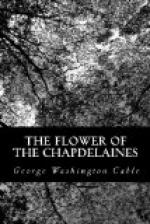The revel always ended with New Year’s Day. The next morning broke silently, and with the rising of the sun the plantation bell or the conch called the bondman and bondwoman into the cane-fields. Then, alike in broadest noon or deepest night, a spectral fear hovered wherever the master sat among his loved ones or rode from place to place. Not often did the hand of oppression fall upon any slave with illegal violence, or he or she turn to slaughter or poison the oppressor; but the slaves were in thousands, the masters were but hundreds, the laws were cruel; the whipping-post stood among the town’s best houses of commerce, justice, and worship, with the thumbscrews hard by. As to armed defense, the well-drilled and finely caparisoned volunteer “troopers” were but a handful, the Danish garrison a mere squad; the governor was mild and aged, and the two towns were the width of the island apart.
XXX
(THE RISING CURTAIN)
In that year, 1848, this unrest was much increased. King Christian had lately proclaimed a gradual emancipation of all slaves in his West Indian colonies. A squad of soldiers had marched through the streets, halting at corners and beating a drum—“beating the protocol,” as it was termed—and reading the royal edict. After twelve years all slaves were to go free; their owners were to be paid for them; and meantime every infant of a slave was to be free at birth.
I suppose no one knows better than the practical statesman how disastrous measures are apt to be when designed for the gradual righting of a public evil. They rarely satisfy any class concerned. In this case the aged slaves bemoaned a promised land they might never live to enter; younger ones dreaded the superior liberty of free-born children; and the planters doubted they would be paid, even if emancipation did not bring fire, rapine, and death.
One day, along with all “West-En’,” as the negroes called Fredericksted—Christiansted was “Bass-En’,”—I saw two British East-Indiamen sail into the harbor. Such ships never touched at Fredericksted; what could the Britons want?
“Water,” they said, “and rest”; but they stayed and stayed! their officers roaming the island, asking many questions, answering few. What they signified at last I cannot say, except that they became our refuge from the black uprising that was near at hand. Likely enough that was their only errand.
Sunday, the 2d of July, was still and fair. To me the Sabbath was always a happy day. High-stepping horses prancing up to the church-gates brought friends from the plantations. The organ pealed, the choir chanted, the rector read, and read well; the mural tablets told the virtues of the churchyard sleepers, and out through the windows I could gaze on the clouds and the hills. After church came the Sunday-school. Its house was on a breezy height where the wind swept through the room unceasingly, giving wings to the children’s voices as we sang, “Now be the gospel banner.”




